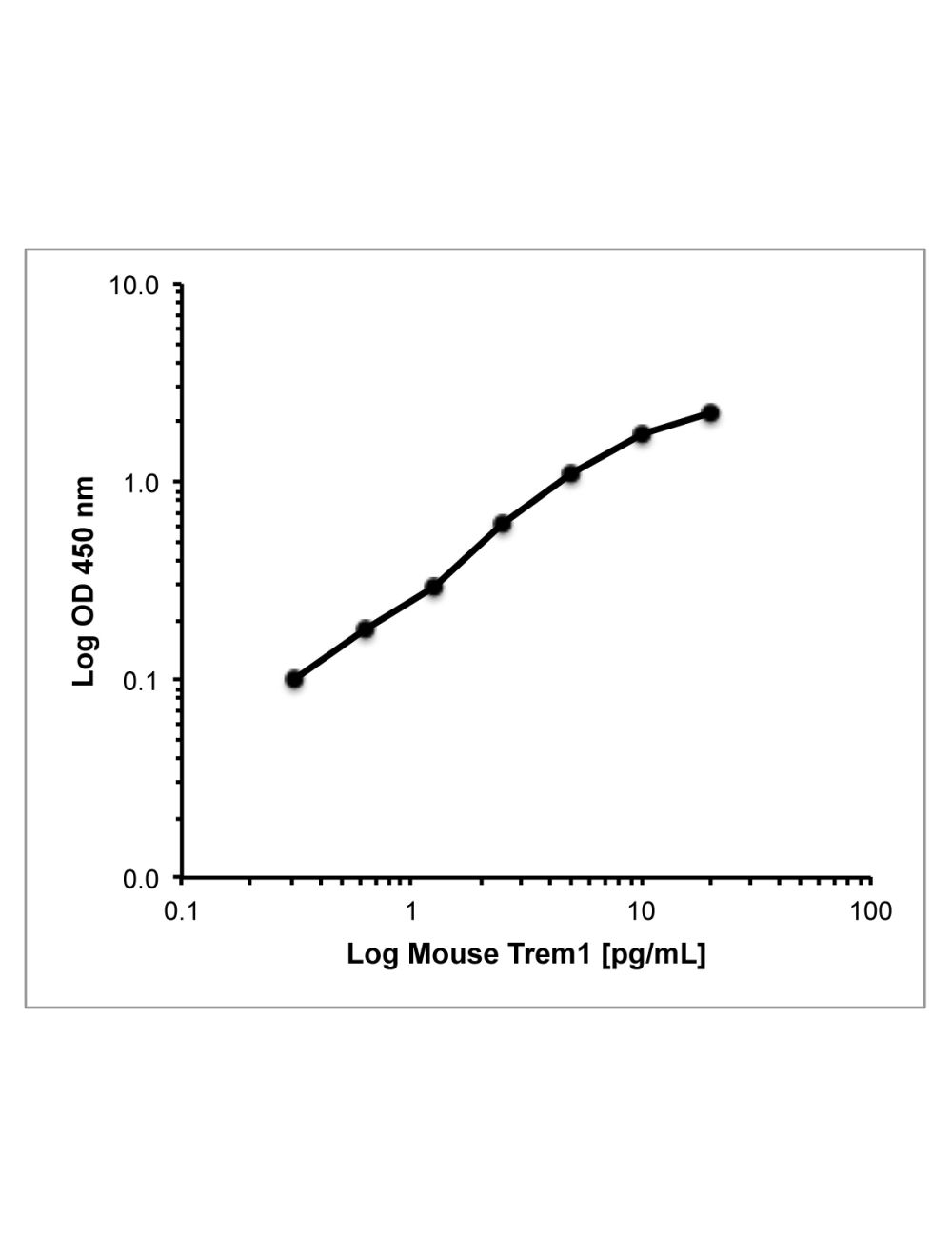Triggering receptor expressed on myeloid cells 1 (Trem-1), Mouse, ELISA assay
As low as
US$547.00
Only %1 left
Catalog Number
BEK-2369
- Product Name Triggering receptor expressed on myeloid cells 1 (Trem-1), Mouse, ELISA assay
- Product Description The Triggering receptor expressed on myeloid cells 1 (Trem-1) Kit is a sandwich ELISA. The capture antibody is a monoclonal antibody pre-coated onto the 96-well strip plates provided in the kit. Mouse test samples and standards of known Trem-1 concentration are added to these wells and allowed to complex with the bound Trem-1 antibody. A biotinylated Trem-1 polyclonal antibody is then added. This detection antibody binds to the antigen thus completing the sandwich. After washing, an enzyme Avidin-Biotin-Peroxidase complex (ABC) is added which binds to the second antibody. The peroxidase substrate TMB is added to induce a coloured reaction product. The intensity of this coloured product is directly proportional to the concentration of Mouse Trem-1 present in the samples. There is no significant cross-reactivity between Trem-1 and its analogs, however cross-reactivity may exist with untested analogs. The purpose of this kit is the in-vitro quantitative determination of Mouse Trem-1 in culture supernatant, serum and plasma (heparin, EDTA) and cell lysates.This kit has been configured for research use only and is not to be used in diagnostic or clinical procedures.
- Alternative Names Triggering receptor expressed on myeloid cells; Trem-1; Trem 1; CD354
- Application(s) ELISA
- Specificity This mouse Trem-1 ELISA assay is reactive to Trem-1 in mouse samples. There is no detectable cross-reactivity with other relevant proteins.
- Species Reactivity Mouse
- Immunogen Description Expression system for standard: NS0; Immunogen sequence: A21-S202
- Range 31.2 pg/mL - 2,000 pg/mL
- Sensitivity < 10 pg/mL
- Regulatory Status For research use only.
Product Info
- Product Description The Triggering receptor expressed on myeloid cells 1 (Trem-1) Kit is a sandwich ELISA. The capture antibody is a monoclonal antibody pre-coated onto the 96-well strip plates provided in the kit. Mouse test samples and standards of known Trem-1 concentration are added to these wells and allowed to complex with the bound Trem-1 antibody. A biotinylated Trem-1 polyclonal antibody is then added. This detection antibody binds to the antigen thus completing the sandwich. After washing, an enzyme Avidin-Biotin-Peroxidase complex (ABC) is added which binds to the second antibody. The peroxidase substrate TMB is added to induce a coloured reaction product. The intensity of this coloured product is directly proportional to the concentration of Mouse Trem-1 present in the samples. There is no significant cross-reactivity between Trem-1 and its analogs, however cross-reactivity may exist with untested analogs. The purpose of this kit is the in-vitro quantitative determination of Mouse Trem-1 in culture supernatant, serum and plasma (heparin, EDTA) and cell lysates.This kit has been configured for research use only and is not to be used in diagnostic or clinical procedures.
- Application(s) ELISA
- Application Details ELISA. For the quantification of Triggering receptor expressed on myeloid cells 1 (Trem-1) in Culture Supernatant, Serum, Plasma (EDTA), Plasma (Heparin) and Cell Lysates. Please download the detailed product insert for complete instructions for the successful use of this ELISA. Use only as directed.
- Target Triggering receptor expressed on myeloid cells 1 (Trem-1)
- Specificity This mouse Trem-1 ELISA assay is reactive to Trem-1 in mouse samples. There is no detectable cross-reactivity with other relevant proteins.
- Target Cross-Reactivity (ELISA) There is no detectable cross-reactivity with other relevant proteins.
- Target Host Species Mouse
- Species Reactivity Mouse
- Immunogen Description Expression system for standard: NS0; Immunogen sequence: A21-S202
- Range 31.2 pg/mL - 2,000 pg/mL
- Sensitivity < 10 pg/mL
- Sample Type Cell Lysates, Culture Supernatant, Plasma (EDTA), Plasma (Heparin), Serum
- Detection Method Colorimetric
- Kit Components The ELISA kit box contains 96-well pre-coated strip plate(s), protein standards, detection reagents, substrate buffer and detailed protocols.
- Storage Instructions Store at 2-8°C
- Storage Temperature 2-8°C
- Batch Number Please see item label.
- Expiration Date This kit may be stored for up to 6 months at 2°C to 8°C from the date of shipment. Standards should be stored at -20°C or -80°C (recommended at –80°C) after reconstitution. Coated strips or reagents may be store for up to 1 month at 2°C to 8°C.
- Alternative Names Triggering receptor expressed on myeloid cells; Trem-1; Trem 1; CD354
- Uniprot Number Q9JKE2
- Uniprot Number/Name Q9JKE2 TREM1_MOUSE;
- Scientific Background Cell surface receptor that plays important roles in innate and adaptive immunity by amplifying inflammatory responses. Upon activation by various ligands such as PGLYRP1, HMGB1 or HSP70, multimerizes and forms a complex with transmembrane adapter TYROBP/DAP12. In turn, initiates a SYK-mediated cascade of tyrosine phosphorylation, activating multiple downstream mediators such as BTK, MAPK1, MAPK3 or phospholipase C-gamma. This cascade promotes the neutrophil- and macrophage-mediated release of proinflammatory cytokines and/or chemokines, as well as their migration and thereby amplifies inflammatory responses that are triggered by bacterial and fungal infections (PubMed:23241959, PubMed:27328755). By also promoting the amplification of inflammatory signals that are initially triggered by Toll-like receptor (TLR) and NOD-like receptor engagement, plays a major role in the pathophysiology of acute and chronic inflammatory diseases of different etiologies including septic shock and atherosclerosis (By similarity). Reference: uniprot.org
- Shipping Statement For order quantities larger than 1 plate, this product is supplied in package units of 2 plates.
- Shipping Temperature 2-8°C (on cold packs)
- UNSPSC CODE 41116158
- Regulatory Status For research use only.

 1800 605-5127
1800 605-5127 +61 (0)8 8352 7711
+61 (0)8 8352 7711

